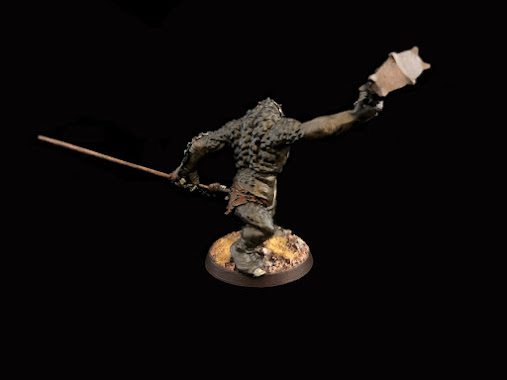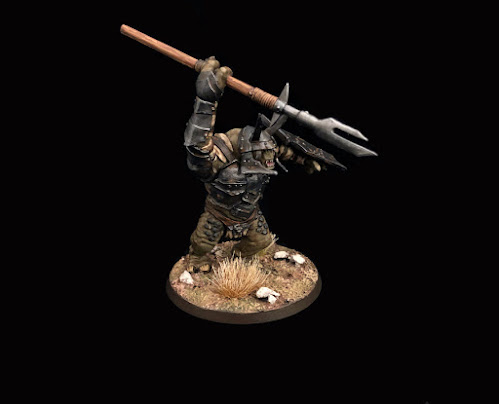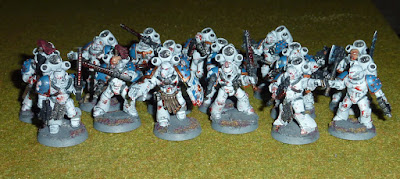Hello everyone.
After a blitzkrieg pace through the Chambers of Challenge, I have finally arrived at the Altar of the Snow Lord. Reaching this room is the culmination of a month's worth of painting until my brushes glowed red hot and my arms ached from the stress of turning a hundred minis to reach every last spot. Well, maybe that is a bit of an exaggeration, but you get the idea.
So, the challenge set for me by our icy overlord was:
Okay Stuart, last year you were working on a WWII Far Eastern Theatre project. Let's see you complete another unit for that collection. Once done, you will have met the challenge and will receive your prize.
Fair enough, a unit for WWII in the far east. No problem.
Actually, when Curt was setting the challenge, I suggested that I could not only paint a unit as above, but it would also be one that most people didn't know about and that, more than likely, no-one had seen on a gaming table before. Hopefully the minis below support that small boast.
As well as quite large selections of troops for the Normandy and Russian campaigns in Europe, I have assembled quite a lot of minis for the Far Eastern Theatre, focusing mainly on the attempted invasion of British India by the Japanese army, followed by the British counter-offensive. In terms of models and rules, this theatre doesn't really get a lot of attention. Sure, you can find Chindits and Gurkhas easily enough, but those were relatively elite groups within the British Indian army. Personally, I am more interested in the other, less elite, but no less important troops that took part in the conflict.
In 1944 the Japanese army launched Operation U-Go, an offensive aimed at entering India through the border with Burma. Planning for the offensive had begun in 1943 after the Chindits had (rather ironically) proven to the Japanese that it was entirely possible for infantry units to advance through the dense jungle and hills along the border. In March, 5 Japanese infantry divisions advanced into the Northeast India regions of Manipur and the Naga hills. The British Indian army had been expecting an attack by the Japanese, but had no idea where or when it would strike. The sudden advance by the Japanese army quickly pushed into the border regions and several British Indian divisions were encircled and trapped in the areas of Kohima and Imphal.
Fighting in these regions would last for nearly 4 months and saw 10s of thousands of casualties and the eventual shattering of the Japanese offensive force. Conditions were harsh, and food, medicine and ammunition were in short supply on both sides.
But, it is to neither of those two armies that I have turned to for this challenge. Instead, I have painted up some of the locals from the region, the Naga people.
The Naga were a group of tribes that lived in the jungles on the edge of India. They were headhunters and farmers, eking out an existence in the harsh climate and on land ill suited for agriculture. Fierce and independent, it was only the arrival of the British that tamed them. In exchange for a cessation of all headhunting (it still happened from time to time), the British supplied the Naga with medicine and heroin (Yes, the Empire did some very questionable, if not downright evil things). This brought relative peace and stability to the region and by all accounts, the Naga had good relationships with the local government representatives. So much so, that when the Japanese invaded, the Naga warriors signed up with the British as scouts, messengers, guides and even soldiers. Among all of the tribes, there were supposedly only two Naga who went over to the Japanese, the others siding with the British.

At first armed only with muzzle loading muskets and their Dao swords, the Naga took on the role of guiding British patrols through the jungle, keeping watch for advancing Japanese units and rescuing downed airmen. Eventually they would receive supplies of more advanced weapons from the British reserves, but they always fought well regardless. That the British took a rather more relaxed view towards headhunting when it was directed against Japanese troops also encouraged the Naga who saw it as an important coming-of-age ritual for young warriors.

Warriors from the tribes would often decorate their skin with tattoos made from tree sap pigments. Only those who had been a part of a headhunting raid were allowed to tattoo their skin in such a fashion. They would traditionally wear necklaces of precious stones, bones and feathers, and wore kilts and wraps of dark cloth with colourful stripes. I have tried to show these elements of their culture through my painting, particularly giving them all tattoos across their faces and torsos.
Of the Naga, Field Marshall William Slim wrote, "Many a British and Indian soldiers owe his life to the naked head hunting Naga, and no soldier of the Fourteenth Army who met them will ever think of them but with admiration and affection."
When I first started researching my Far East project, I was unable to find any miniatures suitable for the Naga tribesmen. Luckily one of my friends is pretty good at sculpting, so I supplied him with a bunch of Zulu sprues from Warlord Games, figuring that their near naked appearance would be a good starting point to build from. My friend did not disappoint and produced these 8 unique miniatures for me. He added earrings and necklaces to some of the models, extended the loincloths into kilts and wraps, added leg wraps and changed the hairstyles of the models. He even managed to get one in a kneeling pose. All in all, they came out very nicely and I hope that my paint job is worthy of his efforts.
If anyone is interested in the battles of Kohima and Imphal, I recommend Road of Bones by Fergal Keane. It is very well written and covers a lot of the events of India in Spring 1944 in all their tragic detail.
So, I hope that the miniatures receive the Snow Lord's seal of approval. Hopefully they also match my boast of being largely unknown and never seen before on a gaming table.
By my calculations, there should be 40 points for the minis and 20 for the chamber added to my total. No skulls, even though they are headhunters, (Heads were kept at the tribes village), but they do add a Squirrel to that tally.
My running Duels totals:
GW Points - 666
Skullz - 371
Squirrels - 12






















































